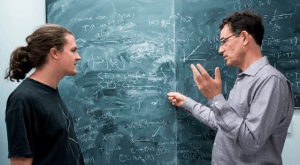
By Michael Franco
Dr. Gielen (left) and his partner on the paper, Neil Turok of the Perimeter Institute for Theoretical Physics (Credit: Perimeter Institute)
We recently reported on a theory that says our universe might not have gotten its start when it collapsed in on itself and exploded. The theory says that such an event may have been prevented by the laws of quantum mechanics, meaning that the beginning of our current universe would have been more of a Big Bounce than a Big Bang.
As the next installment of our regular feature called “One big question”, we asked theoretical physicist Steffen Gielen from Imperial College London exactly what laws of quantum mechanics would have come into play to make the Big Bounce theory tenable. Gielen is one of the authors of a paper detailing the concept. Here’s what he had to say.
One of the main properties of quantum mechanics is that it allows processes that are impossible in classical physics. In particular, there is a phenomenon known as quantum tunneling, of which a good example is radioactive decay. Normally, the attractive nuclear forces hold the nucleus together and nothing can escape. But in radioactive decay, every now and then the “forbidden” process in which a part of the nucleus escapes the nuclear force does occur. Now you can ask the question, “how did the particle do that and escape these forces which look too strong to be overcome?”
It turns out that mathematically, the most accurate description for this “tunneling” process is given by using complex numbers. In a precise mathematical sense, one can say that the particle went through the attractive forces by “escaping” into complex time, rather than following along its usual real time. When time becomes complex, attractive becomes repulsive, allowing the particle to escape.
In our work, the universe pretty much does the same.
Normally one would expect it to collapse onto itself until it reaches a point of infinite density, the “Big Crunch,” which would then become the Big Bang when seen from the other side, where the universe expands again. In terms of cosmological “time”, one would describe this as a process where the universe contracts, hits the Big Crunch/Big Bang at time zero, and then expands as time ticks along.
Now when we use quantum mechanics, we find that a different evolution is possible, in which the universe does not have to go through time zero, but instead goes into complex time, around the singularity at zero. The complex numbers basically give a second dimension to time that the universe can explore, so that the Big Crunch/Big Bang can be avoided entirely. This may sound like a cheat, but as I said is pretty much exactly what happens in real-life situations such as radioactive decay, which can only be understood in quantum mechanics and using complex numbers.
